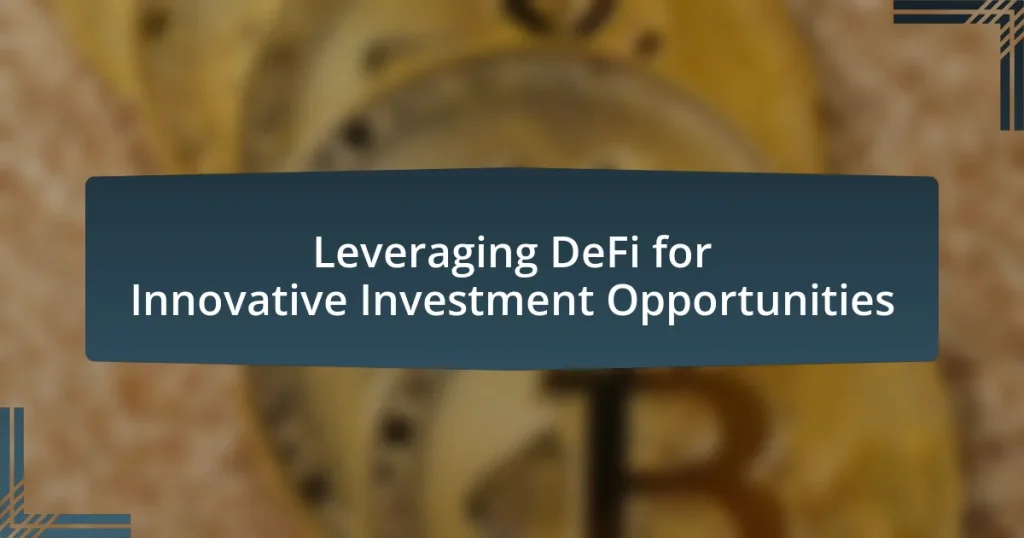Decentralized Finance (DeFi) represents a transformative financial ecosystem built on blockchain technology, enabling peer-to-peer transactions without intermediaries. This article explores how DeFi creates innovative investment opportunities through mechanisms such as yield farming, liquidity mining, and decentralized lending, offering higher returns compared to traditional finance. Key features attracting investors include high liquidity, transparency, and accessibility, while the importance of decentralization enhances security and reduces reliance on centralized authorities. The article also addresses the risks associated with DeFi investments, including smart contract vulnerabilities and market volatility, and provides practical tips for navigating the DeFi landscape effectively. Additionally, it discusses future trends and innovations that may shape the DeFi investment landscape.

What is DeFi and how does it relate to investment opportunities?
Decentralized Finance (DeFi) refers to a financial ecosystem built on blockchain technology that enables peer-to-peer transactions without intermediaries. DeFi creates investment opportunities by allowing users to lend, borrow, trade, and earn interest on cryptocurrencies and digital assets, often with higher returns compared to traditional finance. For instance, as of 2023, the total value locked in DeFi protocols exceeded $50 billion, demonstrating significant capital flow into these platforms, which offer innovative financial products like yield farming and liquidity mining.
How does DeFi differ from traditional finance?
DeFi, or decentralized finance, differs from traditional finance primarily in its reliance on blockchain technology and smart contracts, which eliminate the need for intermediaries like banks. In traditional finance, transactions often require third-party institutions to facilitate and verify, leading to higher costs and slower processes. In contrast, DeFi platforms operate on decentralized networks, allowing for peer-to-peer transactions that are faster and typically less expensive. Additionally, DeFi offers greater accessibility, as anyone with an internet connection can participate, whereas traditional finance often imposes barriers such as minimum investment amounts and geographic restrictions. This fundamental shift enables innovative investment opportunities that are not available in the traditional finance system.
What are the key features of DeFi that attract investors?
The key features of DeFi that attract investors include high liquidity, transparency, and the potential for high returns. High liquidity allows investors to easily enter and exit positions, facilitating efficient trading. Transparency is achieved through blockchain technology, enabling investors to verify transactions and smart contracts, which builds trust in the ecosystem. Additionally, the potential for high returns is often realized through yield farming and staking, where investors can earn significant rewards compared to traditional finance. These features collectively create an appealing environment for investors seeking innovative opportunities in the financial landscape.
Why is decentralization important in DeFi?
Decentralization is important in DeFi because it enhances security, transparency, and accessibility while reducing reliance on centralized authorities. By distributing control across a network of participants, DeFi minimizes the risk of single points of failure and censorship, which can lead to financial loss or manipulation. Furthermore, decentralized protocols allow users to interact directly with financial services without intermediaries, fostering innovation and enabling a broader range of investment opportunities. This structure is supported by blockchain technology, which ensures that all transactions are recorded transparently and immutably, thus building trust among users.
What innovative investment opportunities does DeFi provide?
Decentralized Finance (DeFi) provides innovative investment opportunities such as yield farming, liquidity mining, and decentralized lending. Yield farming allows investors to earn returns by providing liquidity to DeFi protocols, often resulting in higher interest rates compared to traditional finance. Liquidity mining incentivizes users to contribute assets to liquidity pools, rewarding them with tokens that can appreciate in value. Decentralized lending platforms enable users to borrow and lend assets without intermediaries, often with lower fees and faster transactions. These opportunities are supported by the rapid growth of the DeFi sector, which reached over $80 billion in total value locked by mid-2021, demonstrating significant investor interest and potential for high returns.
How can investors access liquidity through DeFi?
Investors can access liquidity through DeFi by utilizing decentralized exchanges (DEXs) and liquidity pools. DEXs allow users to trade cryptocurrencies directly without intermediaries, while liquidity pools enable investors to provide assets in exchange for a share of transaction fees. According to a report by DeFi Pulse, the total value locked in DeFi protocols exceeded $80 billion in 2021, demonstrating the significant liquidity available in this space.
What role do yield farming and staking play in DeFi investments?
Yield farming and staking are crucial components of DeFi investments as they provide mechanisms for users to earn passive income on their cryptocurrency holdings. Yield farming involves lending or providing liquidity to decentralized finance protocols in exchange for interest or rewards, often in the form of additional tokens. This practice incentivizes users to contribute to the liquidity of DeFi platforms, enhancing their overall functionality and stability. Staking, on the other hand, requires users to lock up their assets in a blockchain network to support its operations, such as validating transactions, in return for staking rewards. Both yield farming and staking not only generate returns for investors but also contribute to the growth and sustainability of the DeFi ecosystem by ensuring liquidity and network security.
What risks are associated with leveraging DeFi for investments?
Leveraging DeFi for investments carries several risks, including smart contract vulnerabilities, market volatility, and regulatory uncertainty. Smart contracts, which automate transactions in DeFi, can contain bugs or be exploited, leading to significant financial losses; for instance, the 2020 hack of the DeFi platform bZx resulted in over $8 million lost due to a smart contract exploit. Market volatility is another risk, as the prices of cryptocurrencies can fluctuate dramatically, impacting the value of investments; for example, Bitcoin’s price dropped from nearly $64,000 in April 2021 to around $30,000 in June 2021. Additionally, the regulatory landscape for DeFi is still evolving, and potential future regulations could affect the legality and operation of DeFi platforms, creating uncertainty for investors.
How can smart contract vulnerabilities impact investments?
Smart contract vulnerabilities can significantly impact investments by exposing funds to theft or loss due to coding errors or security flaws. For instance, the DAO hack in 2016 resulted in the loss of $60 million worth of Ether, highlighting how a vulnerability can lead to substantial financial damage. Additionally, vulnerabilities can undermine investor confidence, leading to decreased participation in decentralized finance (DeFi) projects and negatively affecting market liquidity. The presence of known vulnerabilities can also result in increased scrutiny from regulators, potentially leading to legal repercussions for projects and further deterring investment.
What are the implications of market volatility in DeFi?
Market volatility in DeFi leads to increased risk and potential for significant financial loss for investors. This volatility can result in rapid price fluctuations, affecting the value of assets and the stability of liquidity pools. For instance, during periods of high volatility, the value of collateral in lending protocols may drop sharply, triggering liquidations and losses for borrowers. Additionally, market volatility can deter new investors due to perceived risks, impacting overall market participation and liquidity. Historical data shows that during market downturns, DeFi platforms often experience spikes in transaction fees and reduced trading volumes, further illustrating the negative implications of volatility on the ecosystem.
How can investors effectively navigate the DeFi landscape?
Investors can effectively navigate the DeFi landscape by conducting thorough research, utilizing reliable platforms, and diversifying their investments. Researching projects involves analyzing whitepapers, team backgrounds, and community engagement to assess the legitimacy and potential of DeFi protocols. Utilizing reliable platforms ensures that investors interact with secure and reputable exchanges and wallets, minimizing risks associated with hacks and scams. Diversifying investments across various DeFi projects reduces exposure to the volatility of any single asset, as evidenced by the significant fluctuations in token values within the DeFi sector. According to a report by DeFi Pulse, the total value locked in DeFi protocols reached over $80 billion in 2021, highlighting the rapid growth and potential of this investment landscape.
What tools and platforms are available for DeFi investment?
Various tools and platforms are available for DeFi investment, including decentralized exchanges (DEXs), lending protocols, yield farming platforms, and asset management tools. Notable DEXs such as Uniswap and SushiSwap facilitate peer-to-peer trading without intermediaries, while lending protocols like Aave and Compound allow users to lend and borrow assets in a decentralized manner. Yield farming platforms, including Yearn.finance, enable users to earn returns on their crypto holdings by providing liquidity. Additionally, asset management tools like Zapper and DeFi Saver help investors track and manage their DeFi portfolios effectively. These platforms collectively enhance the accessibility and efficiency of DeFi investments.
How do decentralized exchanges facilitate DeFi trading?
Decentralized exchanges (DEXs) facilitate DeFi trading by enabling peer-to-peer transactions without intermediaries, thus enhancing user control over assets. DEXs utilize smart contracts to automate trade execution, ensuring transparency and security in transactions. This model allows users to trade directly from their wallets, reducing the risk of hacks associated with centralized exchanges. According to a report by Dune Analytics, DEX trading volume surpassed $1 trillion in 2021, highlighting their growing importance in the DeFi ecosystem.
What are the best practices for using DeFi wallets securely?
To use DeFi wallets securely, individuals should implement several best practices. First, always enable two-factor authentication (2FA) to add an extra layer of security to wallet access. This practice significantly reduces the risk of unauthorized access, as it requires a second form of verification beyond just a password.
Second, users should regularly update their wallet software to protect against vulnerabilities. Keeping software up to date ensures that any security patches are applied, which is crucial given the rapid evolution of threats in the DeFi space.
Third, it is essential to use hardware wallets for storing significant amounts of cryptocurrency. Hardware wallets provide offline storage, making them less susceptible to hacking compared to software wallets. According to a report by the Blockchain Security Company, hardware wallets are considered one of the safest options for long-term storage.
Fourth, users must be cautious of phishing attacks. Always verify the authenticity of websites and links before entering sensitive information. Phishing attacks have been responsible for a substantial number of DeFi wallet breaches, as attackers often impersonate legitimate platforms.
Lastly, individuals should back up their wallet recovery phrases in a secure location. This practice ensures that users can regain access to their funds in case of device loss or failure. According to the Federal Trade Commission, losing access to recovery phrases can lead to permanent loss of funds.
By following these best practices, users can significantly enhance the security of their DeFi wallets.
What future trends can we expect in DeFi investment opportunities?
Future trends in DeFi investment opportunities include the rise of decentralized autonomous organizations (DAOs), increased integration of artificial intelligence for investment strategies, and the expansion of cross-chain interoperability. DAOs are expected to facilitate community-driven investment decisions, allowing users to collectively manage funds and projects. The integration of AI can enhance decision-making processes by analyzing vast amounts of data for better risk assessment and yield optimization. Additionally, cross-chain interoperability will enable seamless asset transfers and liquidity across different blockchain networks, broadening investment options and enhancing market efficiency. These trends are supported by the growing adoption of DeFi protocols, which saw a total value locked (TVL) increase from approximately $1 billion in early 2020 to over $80 billion by late 2021, indicating a robust and evolving investment landscape.
How might regulatory changes affect DeFi investments?
Regulatory changes can significantly impact DeFi investments by altering the legal landscape in which these decentralized finance platforms operate. For instance, increased regulation may lead to stricter compliance requirements for DeFi protocols, potentially reducing the number of available investment opportunities and increasing operational costs. Historical examples include the implementation of the Financial Action Task Force’s guidelines, which prompted many crypto exchanges to enhance their KYC (Know Your Customer) processes, thereby affecting user accessibility and liquidity in the market. Additionally, regulatory clarity can either foster institutional investment by providing a safer environment or stifle innovation if overly restrictive measures are imposed.
What innovations are on the horizon for DeFi platforms?
Innovations on the horizon for DeFi platforms include the integration of layer-2 scaling solutions, which aim to enhance transaction speed and reduce costs. These advancements are driven by the need for improved user experience and increased scalability, as seen with projects like Optimism and Arbitrum, which have demonstrated significant reductions in gas fees and faster transaction times. Additionally, the development of cross-chain interoperability protocols is set to enable seamless asset transfers across different blockchain networks, enhancing liquidity and user access. This trend is supported by initiatives such as Polkadot and Cosmos, which focus on creating interconnected ecosystems. Furthermore, the rise of decentralized autonomous organizations (DAOs) is expected to empower community governance, allowing users to have a direct say in platform decisions, thereby fostering a more democratic financial ecosystem.
What practical tips can investors follow to maximize their DeFi investments?
Investors can maximize their DeFi investments by diversifying their portfolios across various protocols and assets. Diversification reduces risk and increases the potential for returns, as different DeFi projects may perform differently under varying market conditions. For instance, allocating funds to lending platforms, yield farming, and liquidity pools can provide multiple income streams. Additionally, investors should conduct thorough research on the projects they invest in, focusing on factors such as the team behind the project, its use case, and community support. According to a report by Messari, projects with strong fundamentals and active communities tend to outperform others in the long run. Furthermore, utilizing tools for tracking performance and managing risks, such as portfolio trackers and analytics platforms, can help investors make informed decisions and adjust their strategies as needed.










